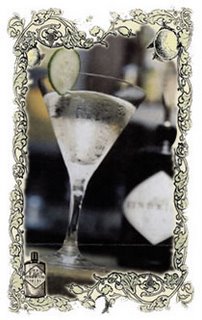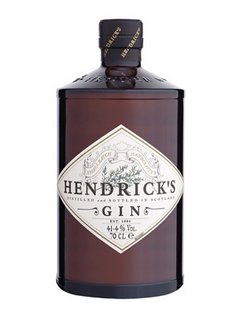So as described, there are almost innumerable variations accorded to the martini. Even with the standard ingredients, variations in quantities or preparation can change the flavour considerably.
The next few entries will look at these variations, starting with the quantity of gin to vermouth.
The original martini was equal parts gin and vermouth. An early recipe I have found describe how to make a Dry Martini.
Dry Martini
1 part Gin
1 part Vermouth
1 dash Angostura Bitters
1 dash Orange Bitters (for extra dry)
As time has altered tastes, the vermouth has almost completely disappeared from the drink. The original recipe used dashes of
angostura bitters and orange bitters to create an extra dry martini, but by today's standards the quantities of vermouth to gin would make it 'wet' instead. These days, a dry martini is created by adding as little vermouth as possible. This is largely due to the ending of prohibition which has improved the quality of gin (during the prohibition gin was made in backyard, or bath tub distilleries), requiring less mixer to make it palatable.
The majority of martini anecdotes base themselves around the amazing disappearing vermouth, the most famous of which is that told of
Winston Churchill who would forgo vermouth completely and instead bow, drink in hand, in the direction of France.
Vermouth avoidance amongst the famous was rife;
General Patton would salute the gin bottle towards Italy,
Alfred Hitchcock would merely 'glance' at the vermouth bottle, and
Ernest Hemingway would order a "Montgomery", a martini mixed at a gin:vermouth ratio of 15:1 (these supposedly being the odds
Field Marshall Montgomery wanted to have before going into battle).
Others would create martinis by rubbing the cork from the vermouth bottle around the glass, or by letting light pass through the bottle onto the glass.
Today, bartenders have found other ways of creating a decent 'dry martini' without the drama of salutations towards distant lands. One lovely bartender at the
Sly Fox Hotel in Sydney would make me dry martinis by pouring a small amount of vermouth over ice cubes sitting in a martini glass. After a few moments of resting, the contents of the glass would be shaken out and the gin poured in. Another variation uses the cocktail shaker. Ice and vermouth are added and then the vermouth drained, leaving vermouth coated ice cubes to chill and flavour the gin.







